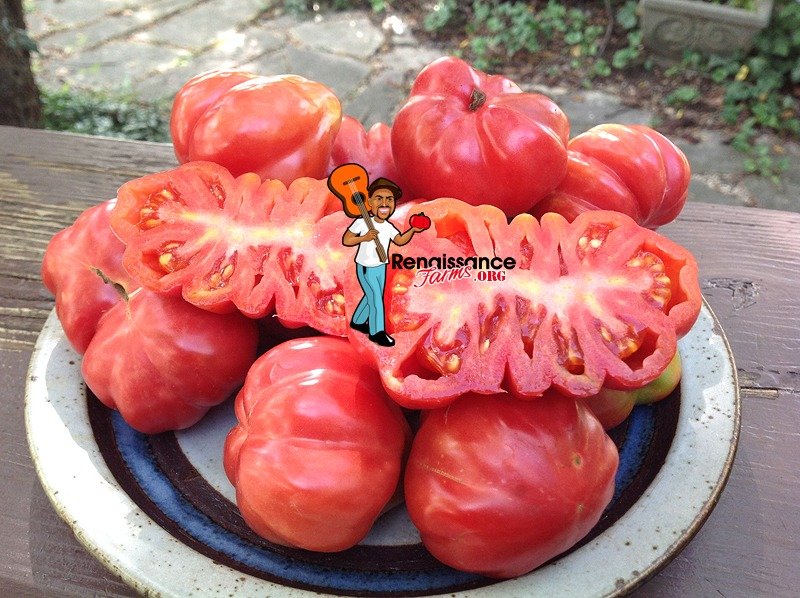Information About Growing Heirloom Tomatoes
Part 1 – Creating A healthy Garden.
I have been a tomato grower for about 40 years. Through the entire experience I have learned some very valuable lessons. I have taken each of these lessons with me and have decided to offer a little bit of information about growing heirloom tomatoes in my blogs and videos. I have also employed methods to maximize my time and efforts. Today, I approach growing very differently than when I first started out, or even in the first ten years for that matter. All things considered, tomatoes are relatively easy to grow if you develop habits that work and duplicate them. Most first timers will have a fair amount of success as long soil conditions are good and plants are fed, staked and garden weeded/maintained in a timely manner. With that said, here is my take. Jump in!
How Big Is Your Tomato Garden? How Many Should You Grow?
The very first thing to consider when growing heirloom tomatoes is spacing. What kind of spacing do you need to grow a specific quantity or variety. For me, spacing is as important as anything else because tomatoes need to breathe and have good ventilation in order to avoid or delay diseases. This is not to say that if they don’t, they will succumb to diseases. They will certainly stand a better chance if they are ventilated properly. I space my tomatoes 4 feet apart, with 5 feet between rows. Although this method works great for me, it may be a bit on the extreme side. Not everyone has that kind of space. So if you have limited space and want to experience several varieties, 2.5 -3 feet apart and 3 feet rows can work fine, if you prune and stake well. The key is to have some space for ventilation between your plants and even on the same vine. A tomato jungle without ample spacing will almost always have health issues. If your space is too small for a garden, container growing is also something to consider.
Crop Rotation For Healthier Plants
One of the biggest reasons why tomatoes get diseased each year, is a lack of crop rotation. If a tomato garden is planted on the same spot each year, problems will inevitably arise. But if you only have one garden, be sure to always replenish your soil after each crop and feed your plants as often as recommended. A lack of crop rotation can promote issues such as aphids and white-flies infestation. If you have the space, try rotating at least two planting spots for your tomatoes. Rotating your garden gives it time to be replenished. Use the off year to rebuild your soil, perhaps by using fresh compost or planting cover crops. Your garden will welcome fresh organic matter. Try some dried leaf chips, or perhaps grass clippings. Depleted soil will most likely create sick plants.
Dwarf Tomatoes Can Work Well
Another thing to consider if you are working with small spaces is dwarf tomato varieties. Most of these varieties can take half as much space as the typical non dwarf sort. Many are high producing also, so yield for space would definitely be worth it. These varieties work well for in-the-ground growing, as well in containers. I plant my dwarfs about 2 feet apart. So that’s two feet closer than my non dwarf varieties. Rows are 3.5 feet apart and not 5 as in non dwarfs. Dwarf tomatoes come in many shapes, sizes and colors just like non dwarfs. So you never have to worry about that.
A Bit About Tomato Diseases
One of the biggest issues that heirloom and open pollinated tomato growers all around the world have, is diseases. Unlike hybrids, heirlooms can be more susceptible to diseases. In fact, diseases of different sorts are almost unavoidable when growing tomatoes. Everything from early blight, leaf spot, wilt and more, may be awaiting your plot. All of these can easily and quickly destroy your crop. So experienced heirloom tomato growers employ different methods of plant care which have been known to effectively work. Preparation is very important for a healthy tomato patch, whether your garden is large or small.
Healthy Soil Will Certainly Help.
One of the most important things that can be done to promote healthy plants is soil preparation. By placing healthy micro organisms in your soil, you can boost the immunity of your crops. To achieve this, I use Buffalo and rabbit manure, Tomato Tone, composted grass clippings, composted foods and a few other things. Planting cover crops in the fall will also help to place nutrients in your soil. The objective would be to have your soil as healthy as possible before planting. Growing disease resistant varieties can definitely help. Another is to keep your seedlings healthy by feeding and fertilizing often. Pathogens can also ride in on your tomato seeds, so be sure to purchase or use seeds that have been properly processed. Certain methods of seed saving will kill diseases on seeds, others wouldn’t. With that said, we can still have a pretty successful season, even with diseases. Being proactive plays a big part in that process, so don’t panic!
In many cases, heirloom tomato plants do not stand up to diseases as well as non-heirlooms. But there are hundreds, perhaps even thousands of varieties that do. The trick is finding them and sharing the great news so that others could grow and promote them too.
Watch out for our Part 2 of this topic! In the mean time you can see here how we feed our tomatoes!
Please Visit and Subscribe To My YouTube Channel Where You Will Find Hundreds Of Videos!





